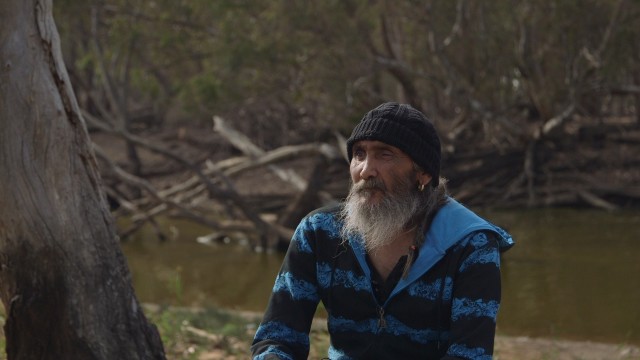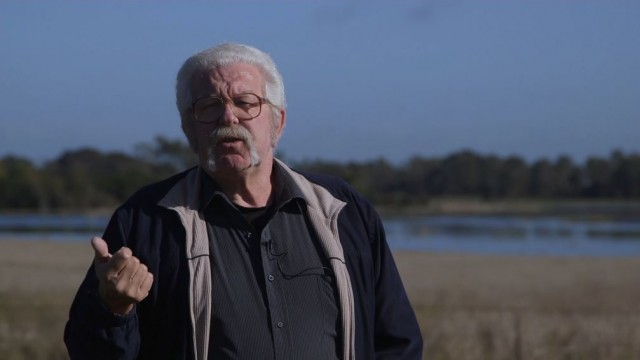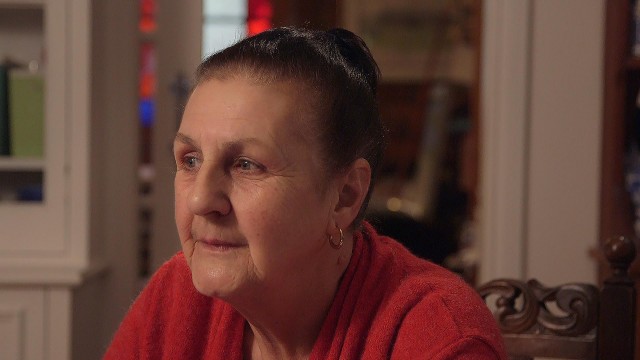Seeing the Land from an Aboriginal Canoe
Info
Commissioned by: Culture Victoria
Produced: 2015
Length: 10.27 minutes
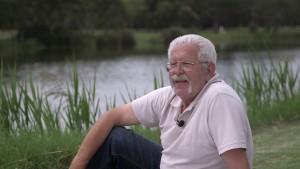
Uncle Bryon Powell, Wadawurrung Elder, talks about stories of canoe use by Wadawurrung people. Interviewed on the banks of the Barwon River, Geelong. Still by Jary Nemo
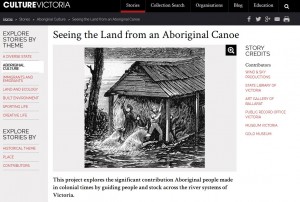
The Culture Victoria project included a full image gallery with archival images, extended audio interviews, and a specifically commissioned documentary.

The Culture Victoria story objects included film, audio and images with curatorial text created by Wind & Sky Productions and three specifically commissioned historical essays written by Fred Cahir and Lucinda Horrocks.

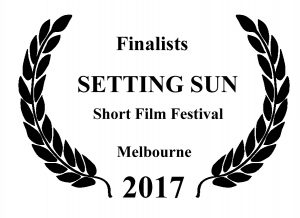
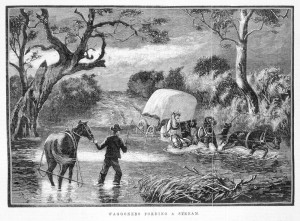
Waggoners Fording a Stream, Illustrated Australian News, engraver FW Sleap, 1883, courtesy of the State Library of Victoria.
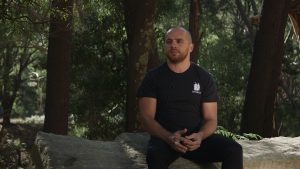
Jamie Lowe, Djabwurrung man. Still by Jary Nemo.
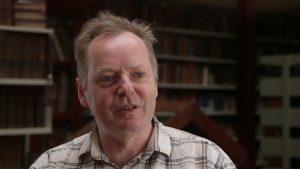
Associate Professor Fred Cahir. Still by Jary Nemo.
The Story
On the rivers of remote Victoria, 19th century European settlers depended on Aboriginal navigators and canoe builders to transport goods, stock and people.
The Aboriginal bark canoe was a technology in demand in regional Victoria in the 1800s. Explorers and drovers, gold miners and settlers used Aboriginal ferrying services and boat building services to conduct trade and transport. Stories abound of trade, canoeing, and heroic rescues on rivers such as the Murray, Goulburn, Campaspe, Ovens and Loddon, shedding light on the generosity, resourcefulness and ingenuity of the Indigenous inhabitants and of the trading relationships formed between Aboriginal people and European colonists. Indeed it could be argued that the waterways skills of Aboriginal Australians were integral to the early economic viability of Victoria.
Multimedia Project
Wind & Sky Productions produced a short documentary film and multimedia gallery for Culture Victoria, curating the online exhibition and producing the text, video, audio and visual content. The project was launched on the 27 May 2015 to mark the beginning of National Reconciliation Week 2015. The documentary film screened at the Big Screen at Federation Square, Melbourne, from the 5-11 July 2015 as part of NAIDOC Week 2015. The project featured interviews with the historian Associate Professor Fred Cahir and Traditional Owners Uncle Bryon Powell, Jamie Lowe and Rick Nelson, and included artwork, maps and photographs from the regional and metropolitan collections of the State Library of Victoria, the Art Gallery of Ballarat, Public Record Office Victoria, Museum Victoria and the Ballarat Gold Museum. Three short historical essays written by Fred Cahir and Lucinda Horrocks were also specially produced for the project. The project was freely available to access by the public from 2015-2022, when the Culture Victoria Portal closed.
Screenings
Online: https://youtu.be/K9QmxoY0TQ0
April 2022, Lonely Wolf International Film Festival Spring Edition
18 June 2017, St Andrews Film Society, St Andrews
26-28 May 2017, Gnarwirring Ngitj Festival, Sovereign Hill Ballarat
28 April 2017, Setting Sun Short Film Festival, Yarraville
28 September 2016, Australian Limnology Conference, Ballarat
July 2016, 2016 NAIDOC Week Special Screening, Child and Family Services (CAFS), Ballarat
27 May 2016, Phee Broadway Theatre, Castlemaine, Reconciliation Week Screenings
9-10 April 2016, Lake Bolac Eel Festival, Lake Bolac
12-14 March 2016, Geelong Wooden Boat Festival, Geelong
20 February 2016, Geelong Environmental Film Festival, Geelong
21 November 2015, Castlemaine Local and International Film Festival (CLIFF), Castlemaine
5-11 July 2015, The Big Screen, Federation Square, Melbourne
Awards
Nominee – Jary Nemo, Outstanding Achievement in Documentary Cinematography, Lonely Wolf International Film Festival, London, Spring 2022.
Nominee – Jary Nemo, Outstanding Achievement in Documentary Editing, Archival Usage & Assembly, Lonely Wolf International Film Festival, London, Spring 2022.
Finalist, Best Cultural Diversity, Setting Sun Short Film Festival, Yarraville, 2017.
Finalist, Best Documentary Metro, Setting Sun Short Film Festival, Yarraville, 2017.
Museums and Galleries National Awards (MAGNA Awards) 2016, Highly Commended, Indigenous Project or Keeping Place, Level 2.
Media
Lucinda Horrocks, ‘seeing the land from an Aboriginal canoe’, Association Magazine, Art Gallery of Ballarat, Autumn 2017, pp.30-33.
Fred Cahir and Lucinda Horrocks, ‘Seeing the Land from an Aboriginal Canoe’, Park Watch Magazine, September 2016 No 266, pp 24-25.
Larissa Romensky, ‘Documentary film explores significance of Aboriginal entrepreneurship in Victoria during colonial times’, ABC Central Victoria, 19 November 2015, http://www.abc.net.au/news/2015-11-19/documentary-film-explores-significance-of-aboriginal-transport/6954288
Shane Fowles, ‘Seeing the Land from an Aboriginal Canoe documentary details indigenous assistance to settlers’, Geelong Advertiser, 7 July 2015, http://www.geelongadvertiser.com.au/news/geelong/seeing-the-land-from-an-aboriginal-canoe-documentary-details-indigenous-assistance-to-settlers/story-fnjuhovy-1227430795289
Lucinda Horrocks radio interview, Breakfast with Dominic Brine, 107.9 ABC Ballarat, 6 July 2015.
Melissa Cunningham, ‘Ballarat’s Aboriginal history set to light up big screen’, Ballarat Courier, 2 July 2015, http://www.thecourier.com.au/story/3185898/unknown-history-explored/
Film Credits
- Produced by:
- Jary Nemo and Lucinda Horrocks
- Production Company:
- Wind & Sky Productions
- Directed and edited by:
- Jary Nemo
- Written and researched by:
- Fred Cahir and Lucinda Horrocks
- Featuring:
- Fred Cahir, Uncle Bryon Powell, Jamie Lowe, Rick Nelson
- Camera and Sound:
- Jary Nemo
- Interviews:
- Lucinda Horrocks
- Archival images courtesy of:
- The Art Gallery of Ballarat and The State Library of Victoria.
- With thanks to:
- Uncle Frank Abrahams, Aunty Vicki Abrahams, John Blythman, Lauren Bourke, Maxine Briggs, Leonie Cameron, Charlotte Christie, Ian Clark, Jeremy Clark, Brett Dunlop, Peter Freund, Richard Gillespie, Barbara Huggins, Karmen Jobling, Tracey Manallack, Rosemary McInerney, Julie McLaren, Kimberley Moulton, Gordon Morrison, Grattan Mullett, Uncle Bill Nicholson, Melanie Raberts, Felicity Say, Vic Say, Aunty Loraine Sellings, Jeanette Tasker, Miriam Troon, Roger Trudgeon, John Tully, Uncle Larry Walsh, Simone Werts, John Young, the Art Gallery of Ballarat, the Ballarat Mechanics Institute, Brambuk National Park & Cultural Centre, Dja Dja Wurrung Clans Aboriginal Corporation, Dunolly & District History, the Gold Museum Ballarat, Federation University Australia, the Koori Heritage Trust, Lake Tyers Aboriginal Trust, Museum Victoria, the Public Record Office Victoria, the State Library of Victoria, the Wathaurung Aboriginal Corporation, and the Wurundjeri Tribe Land and Compensation Cultural Heritage Council.
- Commissioned by:
- Culture Victoria
- Funded by:
- Creative Victoria
- Acknowledgement:
- This film was created for the Culture Victoria website (www.cv.vic.gov.au) with the support of the Victorian Government through Creative Victoria. Film production and development took place on the traditional lands of the Djab Wurrung, Dja Dja Wurrung, Jardwadjali, Wadawurrung (Wathaurung), and Woiwurrung peoples. We would like to acknowledge these traditional owners and pay our respects to their Elders, past and present.
- Copyright with:
- © Wind & Sky Productions 2015.
Project Credits
- Project Acknowledgements:
- Development and filming for this project took place on the traditional lands of the Dja Dja Wurrung, Djab Wurrung, Jardwadjali, Wadawurrung (Wathaurung) and Woiwurrung speaking peoples. The team was also privileged to consult with and to be granted permission to use images and artwork from Taungurung, Yorta Yorta and Gunai/Kurnai speaking peoples. The project team acknowledges the traditional owners of the lands on which we live and work and we pay our respect to their Elders, past and present. Many people worked on this project and helped make it a reality. We thank them all.
- Project Team
- Creative Producers:
- Jary Nemo and Lucinda Horrocks
- Production Company:
- Wind & Sky Productions
- Film Director:
- Jary Nemo
- Writing and research:
- Fred Cahir and Lucinda Horrocks
- Cast:
- Fred Cahir, Uncle Bryon Powell, Jamie Lowe, Rick Nelson
- Acknowledgments by Institution
- Art Gallery of Ballarat:
- Peter Freund, Julie McLaren, Gordon Morrison
- Australian National Maritime Museum:
- David Payne
- Ballarat Mechanics Institute:
- John Blythman, Rosemary McInerney
- Brambuk National Park and Cultural Centre:
- Uncle Frank Abrahams, Aunty Vicki Abrahams, Jeremy Clark, Jamie Lowe
- BrainTrain:
- Bill Horrocks, Heather Horrocks
- Castlemaine ANTaR:
- Rick Nelson, Paulette Nelson, Felicity Say, Vic Say
- Cummerugunja Local Aboriginal Land Council:
- Rebecca Atkinson
- Culture Victoria:
- Dimity Mapstone, Eleanor Whitworth, Tanya Wolkenberg
- Dja Dja Wurrung Clans Aboriginal Corporation:
- Barbara Huggins
- Dunolly Museum:
- John Tully
- Federation University Australia:
- Fred Cahir, Ian Clark, John McDonald
- Footscray Community Arts Centre:
- Uncle Larry Walsh
- Gunaikurnai Land & Waters Aboriginal Land Corporation:
- Grattan Mullett
- Koori Heritage Trust:
- Nerissa Broben, Charlotte Christie
- Lake Tyers Aboriginal Trust:
- Leonie Cameron, Aunty Lorraine Sellings, Jeanette Tasker
- Museum Victoria:
- Richard Gillespie, Kimberley Moulton, Melanie Raberts, Miriam Troon
- Public Record Office Victoria:
- Lauren Bourke, Tracey Manallack
- Sovereign Hill Museums Association: Gold Museum, Ballarat:
- Brett Dunlop, Roger Trudgeon
- State Library of Victoria:
- Maxine Briggs
- Wathaurung Aboriginal Corporation trading as Wadawurrung:
- Uncle Bryon Powell, John Young, Simone Werts
- Wind & Sky Productions:
- Lucinda Horrocks, Jary Nemo
- Wurundjeri Tribe Land and Compensation Cultural Heritage Council Incorporated:
- Uncle Colin Hunter, Karmen Jobling, Aunty Alice Kolasa, Uncle Bill Nicholson, Charley Woolmore
- Yorta Yorta Nation Aboriginal Corporation:
- Aunty Janice Muir, Aunty Elsie Bailey, Ruben Baksh
- Commissioned by:
- Culture Victoria
- Funded by:
- Creative Victoria
- Copyright with:
- Content Producers and Collection Holders.
Uncle Bryon Powell – M.A.D.E Digital Stories
Info
Client: Museum of Australian Democracy at Eureka
Produced: 2014
Length: 4.07 minutes
Uncle Bryon Powell is a Wathaurung Elder. His family can trace its descent to the traditional owners of the land around the Ballarat region. At Wathaurung Corporation, Uncle Bryon maintains links with Ballarat’s Indigenous past and culture through ceremony, education and consultation. The story of Indigenous people during the time of Eureka has not been told, argues Uncle Bryon. In this film Uncle Bryon introduces the undisturbed location of Winter’s Swamp, near Ballarat, which contains remnants of Indigenous inhabitation going back hundreds, perhaps thousands of years. He talks about what life was like for Indigenous people before colonisation and details the resilience and adaptability of Wathaurung people on the goldfields in the face of the challenge to their culture and the transformation of their land.
Wind & Sky Productions produced four short digital stories for the Museum of Australian Democracy at Eureka as part of the commemoration of the 160th Anniversary of the Eureka Stockade. The films are on permanent display in the Museum touchtable exhibition.
Screenings
On permanent display, Museum of Australian Democracy at Eureka, Ballarat.
21 November 2015, Castlemaine Local and International Film Festival (CLIFF)
Credits
- Produced by:
- Jary Nemo and Lucinda Horrocks
- Production Company:
- Wind & Sky Productions
- Directed and edited by:
- Jary Nemo
- Written and researched by:
- Lucinda Horrocks
- Featuring:
- Uncle Bryon Powell
- Camera and Sound:
- Jary Nemo
- Interviews:
- Lucinda Horrocks
- Archival images courtesy of:
- The Gold Museum, Ballarat, The State Library of Victoria, The National Gallery of Victoria, The W.L. Crowther Library, Tasmanian Archive and Heritage Office.
- With thanks to:
- Adrian Burrow, Fred Cahir, Ian Clark, Gary Presland, Claire Muir, Hedley Thomson, the Ballarat Environment Network (BEN), the Department of Environment and Primary Industries (DEPI), and the Wathaurung Aboriginal Corporation.
- Commissioned by:
- Jane Smith, Museum of Australian Democracy at Eureka.
- Funded by:
- Victorian Department of Premier and Cabinet.
- Acknowledgement:
- We give thanks to the Wathaurung people of the Kulin Nation, the traditional owners of the land where the Eureka Stockade took place, and pay respect to their Elders past and present.
- Copyright with:
- © M.A.D.E. Ballarat 2014. All rights reserved.
Aunty Marlene Gilson – M.A.D.E Digital Stories
Info
Client: Museum of Australian Democracy at Eureka
Produced: 2014
Length: 4.19 minutes
Links
Lucinda’s behind the scenes story ‘Painting Stories – Aunty Marlene Gilson‘
Aunty Marlene Gilson is a Wathaurung (Wadawarrung) Elder living on country in Gordon, near Ballarat. A visual artist who discovered painting later in life, Aunty Marlene’s paintings explore Aboriginal myth and stories of the goldfields. Her work is marked by a naive style which references her Indigenous and European ancestry. She is a descendent of King Billy, an Indigenous tribal leader of the Ballarat region at the time of the Eureka Stockade, and his wife Queen Mary. In this short film Aunty Marlene describes the stories she depicts in her paintings ‘Mount Warrenheip and Eureka Stockade’ (2013) and ‘Life on the Goldfields’ (2014). She talks of life for her ancestor King Billy, the wearing of breast plates, Indigenous women’s skills of basket weaving and textiles, and she speculates on what Indigenous people must have felt at the time of Eureka.
Wind & Sky Productions produced four short digital stories for the Museum of Australian Democracy at Eureka as part of the commemoration of the 160th Anniversary of the Eureka Stockade. The films are on permanent display in the Museum touchtable exhibition.
Screenings
On permanent display, Museum of Australian Democracy at Eureka, Ballarat.
21 November 2015, Castlemaine Local and International Film Festival (CLIFF)
Credits
- Produced by:
- Jary Nemo and Lucinda Horrocks
- Production Company:
- Wind & Sky Productions
- Directed and edited by:
- Jary Nemo
- Written and researched by:
- Lucinda Horrocks
- Featuring:
- Aunty Marlene Gilson
- Camera and Sound:
- Jary Nemo
- Interviews:
- Lucinda Horrocks
- Artwork:
- ‘Mount Warrenheip and Eureka Stockade’ © Marlene Gilson, 2013, ‘Life on the Goldfields’ © Marlene Gilson, 2014.
- Archival images courtesy of:
- Art Gallery of Ballarat, Ballarat Historical Society, Old Colonists Club, Ballarat, The Gold Museum, Ballarat, State Library of Victoria.
- With thanks to:
- Fred Cahir, Ian Clark, Peter Freund, Clare Gervasoni, Barry Gilson, Deanne Gilson, Gordon Morrison, David Miller, Claire Muir, Janice Newton, Roger Trudgeon, the Old Colonists Club Ballarat, and the Art Gallery of Ballarat.
- Commissioned by:
- Jane Smith, Museum of Australian Democracy at Eureka.
- Funded by:
- Victorian Department of Premier and Cabinet.
- Acknowledgement:
- We give thanks to the Wathaurung people of the Kulin Nation, the traditional owners of the land where the Eureka Stockade took place, and pay respect to their Elders past and present.
- Copyright with:
- © M.A.D.E. Ballarat 2014. All rights reserved.
Report of the First Week of December 2014
By Lucinda Horrocks 12 December 2014.
On the morning of the 3rd of December Jary and I woke blurry eyed, well before sunrise. At 3:30am we drove through a dark and silent Ballarat to Main Road, towards the glowing beacon of Sovereign Hill’s mining tower which after dark is always lit from below, where we joined a procession of cars in the otherwise empty street heading towards the museum’s entrance. At the brightly-lit reception, smiling staff in period costume ushered us, the blinking and the bewildered, into the museum’s 19th century streets.
So it started at 3am on the third of December. And it didn’t stop until Sunday the 7thth. In a special week, we got to celebrate many events to do with projects we have worked on over the last five years. Trust me, weeks like this are unusual.
Read MoreEvent: Eureka Stories
Stories of Eureka
On December 3 1854, in Ballarat, a group of gold miners clashed with the local authorities in a bloody encounter which influenced the course of democracy in Australia.
We’ve been busy at Wind & Sky creating four digital stories about people connected to the Eureka Stockade for the Museum of Australian Democracy at Eureka (M.A.D.E Ballarat).
Come help us celebrate the launch of our films and the 160th anniversary of Eureka. There are a series of events on the actual anniversary day the 3rd of December and on the weekend of the 6-7 December.
Read MoreThe Blog
- All (94)
- Commissioning Advice (3)
- Events (24)
- Image Galleries (3)
- Media Releases (12)
- Project Stories (16)
- Welcome (1)
- Wind & Sky Digest (44)
What's New
‘The Missing’ wins Best Short Documentary Award in Zurich
‘The Missing’ has won the ‘Best Short Documentary’ award at the Inspirational Film Festival in Zurich.
Lucinda Horrocks writes ‘Discovering an Archive’
Wind & Sky Producer Lucinda Horrocks has written an article for Provenance Journal.
‘The Missing’ nominated for awards in Berlin, Tokyo and Hawaii
‘The Missing’ has been nominated for several global awards
‘The Missing’ Nominated in British Short Film Awards
‘The Missing’ has been nominated for an award at the British Short Film Awards.
 Wind & Sky Productions
Wind & Sky Productions